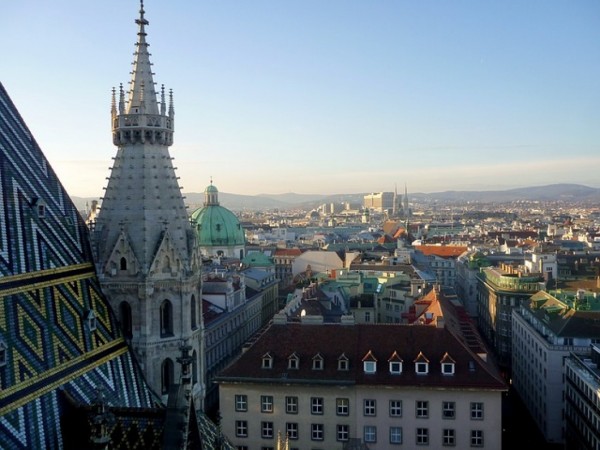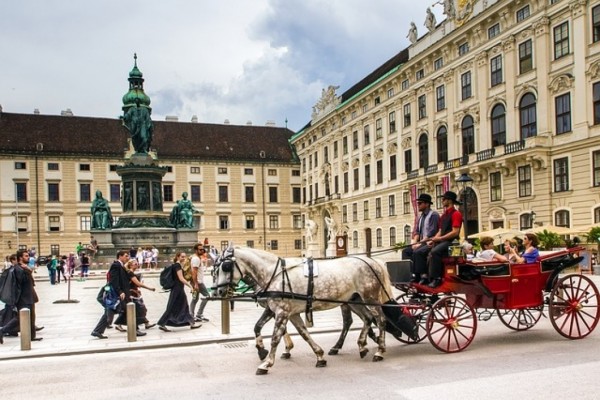Austria is situated in the south-east of Central Europe. It is predominantly a country of upland areas and high mountains - the Eastern Alps occupying a good 60 per cent of the country's territory. The River Danube flows for about 350km/217 miles from west to east through the northern part of Austria. With an area of 83,855 sq.km/32,376 sq. miles Austria is one of the smallest countries in Europe.
Austria has a cool temperate climate of an Alpine character, consistent with its position on the south-eastern edges of Central Europe and its mountainous terrain. Towards the east the climate takes on increasingly continental characteristics.
This information has been compiled for your reference in good faith but please use this only as a general guide. We advise you to check with relevant authorities with regard to the latest requirement for passport, visa, travel advisory, entry restrictions, health requirements, local currency etc as these are subjected to change with without prior notice and our information given below may not be as updated.
Best time to go: The best time to visit Austria is during the shoulder months, in spring, between April – May, and in fall, between September – October. The weather is excellent for outdoor activities, and the crowd is sparser. The high tourist season between June – August sees excellent weather and sunny days. However, the prices of travel and accommodation would be in higher side, and expect a tourist rush in all popular destinations.
The low season is between November – March, when many of the smaller towns close down for winter. There are a lot of cultural activities in Vienna in this season. Peak ski season is between December – March.
The Austrian flag is one of the oldest national flag in the world
Visa: New Zealand citizens do not require a visa to enter the Schengen area. Non-EU citizens (incl. U.S. citizens) entering Austria under the Visa Waiver Program must have a passport valid for a period of at least 3 months beyond the planned date of departure from the Schengen area.
You thought Hitler was German? Nope. He was Austrian too
Currency: The Austrian currency. The Euro (symbol: €) became the official Austrian currency since 2002. Austria uses the full range of Euro coins (one cent, two cents, five cents, 10 cents, 20 cents, 50 cents, one Euro, two Euros) and notes (five Euros, 10, 20, 50, 100 and 500)
Money can be exchanged in banks, at foreign exchange bureaus and hotels. ATMs can be found in large towns especially in all the tourist areas. ATMs tend to chuck out 100 Euro notes where they can. Small shops and street vendors may not have change for such a big note, so withdraw a sum like 190 Euros or 290 Euros to get plenty of smaller notes. Also, always carry a few 1 and 2 Euro coins with you – they’re ideal for shopping trolleys, buying newspapers from street vendors etc.
The world's largest emerald (2860 carat) is displayed in the Imperial Treasury of the Hofburg (Imperial Palace) in Vienna
Health: Austria does not have any particular health risk. Foreign visitors should check at home whether you need vaccinations or not, but the general rule is that you won't. All travellers should be up to date on routine vaccinations when travelling to Austria and keep your valid up to date travel insurance when required.
Vienna's Central Cemetery (Zentralfriedhof) has over 2.5 million tombs (more than the city's live population).
Food and drinks: Foodies will adore Vorarlberg's Bergkäse cheese, Styria's Weissburgunder wines and pumpkin seed oil. Warm up with hearty Austrian fare like spicy goulash in the Alps, tuck into Wiener Schnitzel with potato salad in the city, washed down with gold-hued beer. And don't forget to save room for fluffy apple strudel or chocolatey Sacher Torte.
Almdudler is an Austrian famous soft drink based on mountain herbs and with a flavour reminiscent of elderflower beverages. It is considered the 'national drink of Austria', and is popularly used as a mixer with white wine or water. The popular energy drink Red Bull became popular in the West starting in Austria. You may find some cities are imposes few restrictions on the sale of alcohol, so except in alcohol-free places, you should be able to order beer or wine with your meal, even if it's 9am. Many Viennese have their first strong drink in the morning, preferring beer over coffee to get them going.
In general, Austrian wines are served when new, and most are consumed where they're produced. More than 99% of all Austrian wine is produced in vineyards in eastern Austria: principally Vienna, Lower Austria, Styria, and Burgenland. The most famous Austrian wine, Gumpoldskirchen, which is sold all over Vienna, comes from Lower Austria, the country's largest wine producer.
Austria's flag is one of the oldest in the world
Clothing: Man's traditional clothing is made from leather, linen and wool. 'Lederhosen', knee-length trousers or short-pants made from leather are worn with rustic shoes and wool socks. In Austria, people still enjoy wearing 'tracht' on official occasions like weddings, festivals, etc. Austrians, like many of their European neighbors, dress in a sophisticated, faily conservative way, and overly revealing clothing is generally frowned upon.
You probably already know the most famous currently living Austrian - Arnold Schwarzenneger
Language: Austrian German is spoken by most Austrians with the exception of a section of the aged population (mostly rural residents). German is used in imparting education in the schools and universities of the country. The media also uses the language as a means of communication, and all official announcements and government administrative work use Austrian German. There are a number of languages spoken in Austria by the various minority populations in Austria. English, French, and Italian are three important foreign languages spoken in Austria.
The Krimml Falls (Krimmler Wasserfalle) are Europe's tallest waterfall (380 meters) is in Austria
Gratuities: In Austria, many restaurants include tax and a service charge in their bills, and it is customary to round up the total when paying. If you have enjoyed your meal and experience then tipping 10-15% or so is a reasonable tip for staff. People often tip porters. For taxi drivers round up to the nearest euro and for good service you can leave gratuity up to 10%.
After Luxembourg, Switzerland, and the Scandinavian countries, Austria has the highest number of Nobel Prize winners per capita
Safety & security: Generally speaking, there is not much to worry about when it comes to safety and security in Austria. However as a generic note you need to take care of your personal safety and looking after your belongings so that you can have a safe and enjoyable time while travelling.
Airport tax: Generally your international air ticket should include airport tax on international departure.
In spite of the mishap with the elephant, Vienna is home to the world's oldest zoo, the Tiergarten Schönbrunn
Internet: Internet facilities are available at almost in many places. Most hotels have it and internet cafes are commonly found in all major cities and tourist places.
Telephone: Austria has a dialling code of +43 from New Zealand. While calling New Zealand from Austria, you will need to dial +64…Pre-paid calling cards are sold in many shops and airport. If you want to call internationally, ask for an international calling card.
In Austria, German is the official language, although English is good in most places
Time Difference: Austria is 10 hours behind New Zealand from April to September and 11 hours from October to March.
Photography: It is normally forbidden to take photographs of government buildings, airports and buildings of military importance. Many museums prohibit photography without a permit; some prohibit only flash or tripod photography.
Austria is constantly ranked as having one of the highest standards of living in the world and Vienna nearly always tops the list of the World's Most Livable Cities.
Electricity: For Austria there are two associated plug types, types C and F. Plug type C is the plug which has two round pins and plug type F is the plug which has two round pins with two earth clips on the side. Austria operates on a 230V supply voltage and 50Hz. Few Hotels have adapters available which you could borrow free of charge during your stay but it might be a good idea to carry one from home. Please visit this website for more information on plugs: http://kropla.com/electric2.htm
Postage: Austrian Post is Austria’s leading logistic and postal services with very good services and reputation.
St. Peter Stiftskeller is the oldest still-operating inn/restaurant in the world. It opened in 803 AD. That's more than 1200 years ago
Cities of interest
Vienna
Vienna, Austria’s capital, lies in the country’s east on the Danube River. Its artistic and intellectual legacy was shaped by residents including Mozart, Beethoven and Sigmund Freud. The city is also known for its Imperial palaces, including Schönbrunn, the Habsburgs’ summer residence. In the MuseumsQuartier district, historic and contemporary buildings display works by Egon Schiele, Gustav Klimt and other artists.
The elegant Ring Road around the Innere Stadt district features government and public buildings including the 18th-century Burgtheater, where the Vienna State Opera presents numerous productions yearly and hosts the annual Vienna Opera Ball, one of a series of glittering city events. The Hofburg Imperial Palace has lavish Habsburg apartments and hosts displays by the Spanish Riding School’s renowned Lipizzaner stallions. A symbol of the city, Gothic St. Stephen's Cathedral sports a colorful tile roof. The Wiener Riesenrad Ferris wheel in the Prater park has far-reaching rooftop views.
Salzburg
Salzburg, an Austrian city on the border of Germany with views of the Eastern Alps. The city is divided by the Salzach River, with medieval and baroque buildings of the pedestrian Altstadt (Old City) on its left bank, facing the 19th-century Neustadt (New City) on its right. The Altstadt birthplace of famed composer Mozart is preserved as a museum displaying his childhood instruments.
In the Neustadt, the neoclassical Mirabell Palace formed a backdrop to the film "The Sound of Music." On a hilltop in the Altstadt, the imposing medieval Hohensalzburg Fortress has richly decorated Gothic chambers and a museum. The DomQuartier includes the baroque archbishops’ palace and the 17th-century cathedral with its 4,000-pipe organ. Close to Mozart's birthplace is the charming Getreidegasse shopping street. To the south is Renaissance Hellbrunn Palace, with a pleasure garden containing "trick" fountains, plus the neighboring city zoo.
Hallstatt
Village located on Lake Hallstatt's western shore in Austria's mountainous Salzkammergut region. Its 16th-century Alpine houses and alleyways are home to cafes and shops. A funicular railway connects to Salzwelten, an ancient salt mine with a subterranean salt lake, and to Skywalk Hallstatt viewing platform. A trail leads to the Echern Valley glacier garden with glacial potholes and Waldbachstrub Waterfall.
Explore the Gems of East Europe
Join this memorable nine-day tour to have the ultimate east European experience. Get in touch with history and culture, indulge in mouth-watering cuisine, and let the most beautiful cities in East Eur9 DAYS
Gems Of East Europe
Enjoy this memorable tour and get closer to Eastern European beautiful history and mythology, while admiring stunning landscapes, and indulging in mouthwatering food.8 DAYS
Vienna - Budapest - Bratislava by Train
This will be a memorable tour for you, covering the three capitals by train. An experience to remember for life. You will visit the beautiful Schonbrunn Palace in Vienna, Fisherman’s Bastion in Budape8 DAYS


